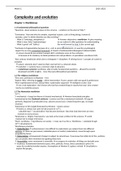Samenvatting
Samenvatting 'Complexity and Evolution' -17/20 in 1e zit!
Deze samenvatting omvat de gehele cursus 'Complexity and Evolution' overeenkomstig met het gelijknamige lesonderdeel. Het document is gestructureerd volgens hoofdstukken en paragrafen om het geheel overzichtelijk te houden. Per paragraaf worden de belangrijkste concepten en denklijnen schematisch m...
[Meer zien]



